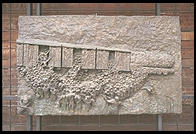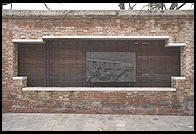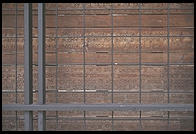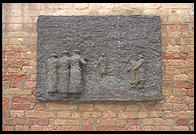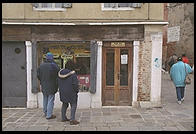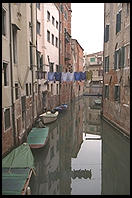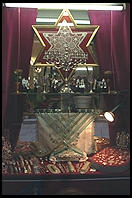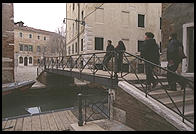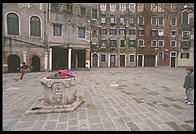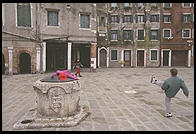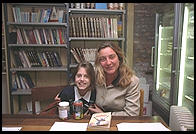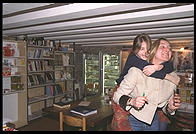There are plenty of tourists in Cannaregio, but in many ways this part of the
city has been relatively unaffected by tourism. There are a lot of peaceful
out-of-the-way spots in Cannaregio.
The Ghetto
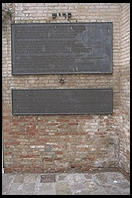 "Ghetto" means "foundry" in Venetian and it was here that the word obtained its
modern meaning. In 1516, the Jews of Venice were confined in this area by the
Council of Ten. Unlike other European cities, the Venetians did not have to build
walls to keep their Jews locked up; the area was already an island so they just
posted guards on the bridges. Jews were allowed out of the ghetto during the day
to practice their three legal occupations: textile trading, medicine, and
banking.
"Ghetto" means "foundry" in Venetian and it was here that the word obtained its
modern meaning. In 1516, the Jews of Venice were confined in this area by the
Council of Ten. Unlike other European cities, the Venetians did not have to build
walls to keep their Jews locked up; the area was already an island so they just
posted guards on the bridges. Jews were allowed out of the ghetto during the day
to practice their three legal occupations: textile trading, medicine, and
banking.
Very confusingly, the "new Ghetto" was the first part of the Jewish
settlement. When the population swelled with Jews expelled from other countries,
the adjacent "old Ghetto" was occupied as well ("new" and "old" refer to the
foundries that were there centuries before). Napoleon emancipated the Jews in
1797 but the Austrians pushed them back into the ghetto and they weren't about to
get out until 1866, when Venice joined Italy.
The peak of the ghetto's population was about 5,000. By World War II, the
population had fallen to about 1,300. The Germans killed 200, who are remembered
with a couple of nicely kept Holocaust memorials, and today perhaps as few as 300
remain. That the community is dying is evident from the synagogue tour. A new
woman's section was added to the ground floor of the Spanish synagogue; it seems
that the average woman in the congregation is too old to manage the stairs up to
the original women's gallery.
I've visited the ghetto twice, once in September and once in January. In both
times, the main campo seemed rather deserted and depressing. I asked Susanna, one
of the tour guides, whether it was a desirable place to live for modern
Venetians. "Oh yes," she replied. "It is close to the train station, so that
makes it a good place to be. Tourists want to be close to San Marco, but we like
to be close to the mainland."
All of the Venetian Jews that I met seem to spend a lot of their time in
Israel or New York.
Santa Maria dei Miracoli
Built in 1489 by Pietro Lombardo, this church is now a favorite spot for
Venetian marriages. The place is lined inside and out with beautiful pieces of
marble. Originally, the church was built to hold a painting (Virgin and
Child (1408)) with miraculous powers.
philg@mit.edu
 "Ghetto" means "foundry" in Venetian and it was here that the word obtained its
modern meaning. In 1516, the Jews of Venice were confined in this area by the
Council of Ten. Unlike other European cities, the Venetians did not have to build
walls to keep their Jews locked up; the area was already an island so they just
posted guards on the bridges. Jews were allowed out of the ghetto during the day
to practice their three legal occupations: textile trading, medicine, and
banking.
"Ghetto" means "foundry" in Venetian and it was here that the word obtained its
modern meaning. In 1516, the Jews of Venice were confined in this area by the
Council of Ten. Unlike other European cities, the Venetians did not have to build
walls to keep their Jews locked up; the area was already an island so they just
posted guards on the bridges. Jews were allowed out of the ghetto during the day
to practice their three legal occupations: textile trading, medicine, and
banking.